Do you have a tough time finding colorful flowers to grow in shady areas of your garden? Look no further! We’ve compiled a list of gorgeous and easy-to-grow flowers for partial sun beds and containers. From bright begonias plants to exotic fuchsia shrubs, there’s something to delight every gardener. And once these nine divine partial sun annual flowers bloom, we think you’ll be excited to plant even more.
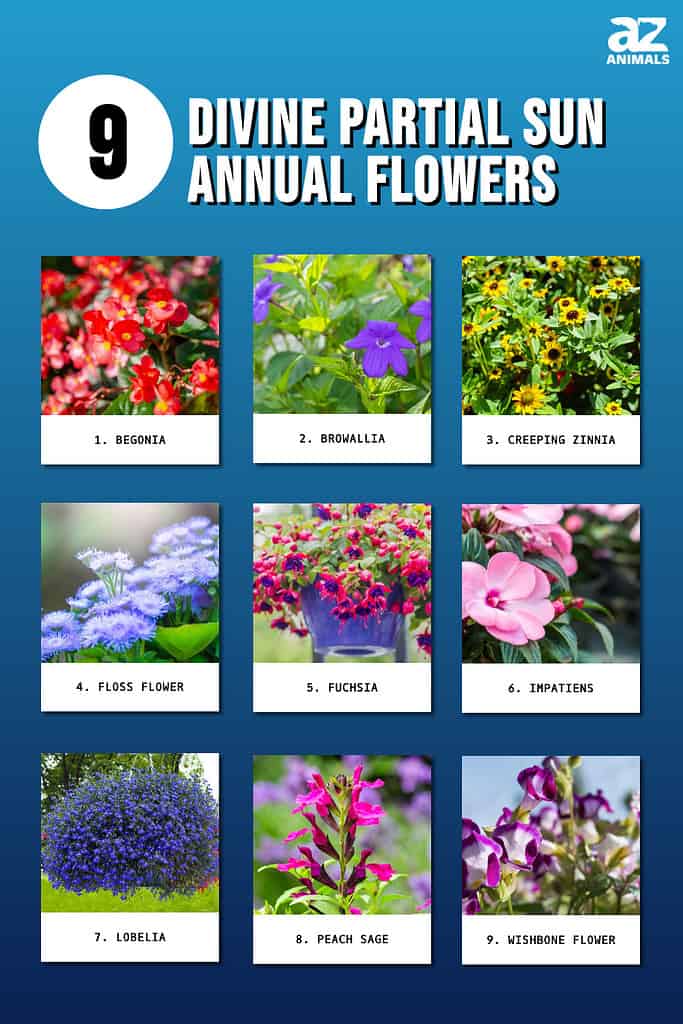
Read on to select your favorites from the list of partial sun annual flowers below. We hope it’s a mix of old favorites and some new surprises for you too!
1. Begonia
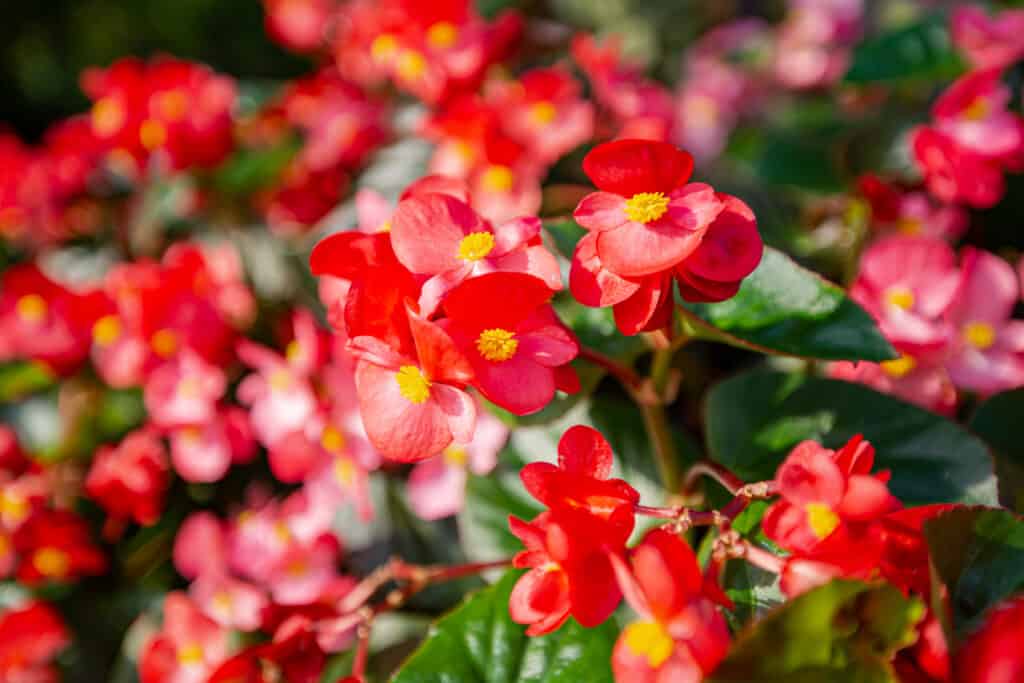
Begonia plants are ideal for a partial shade garden.
©iStock.com/deaw59
Botanical name: Begonia x tuberhybridia ‘Nonstop Fire’
Common names: double begonia, tuberous begonia, Nonstop Fire begonia
USDA hardiness zones: 10 to 11
Sun exposure: partial sun
Mature size: up to 12 inches with a 24-inch spread
Bloom time: spring to fall
Flower colors: yellow and orange
Most begonia plants are ideal for partial shade gardens, whether they’re wax, tuberous, or another variety. But we chose the tuberous begonia hybrid ‘Nonstop Fire’ as a standout for home gardening. This annual flower lights up any semi-shady area with its rose-like double blooms in yellow and orange.
‘Nonstop Fire’ is a bushy mound-shaped begonia plant with dark green foliage. If you live in hardiness zones 10-11, your begonia might grow again next year. Everybody else grows it as a partial shade annual flower. However, you can also dig up the tubers and store them over winter to produce the same plant again next year.
Also, pet owners should be aware that tuberous begonias are toxic for cats, dogs, and horses.
- Watering needs: Water begonias every 2-4 days in well-draining soil.
- Maintenance: Begonias need good circulation in slightly acidic soil. Fertilizers high in nitrogen are ideal for this plant, applied once or twice a month for the best performance.
- Garden pests: Snails, thrips, mealybugs, and spider mites all love to attack begonias.
- Common diseases: Begonias could get leaf spot, root rot, or powdery mildew.
2. Browallia
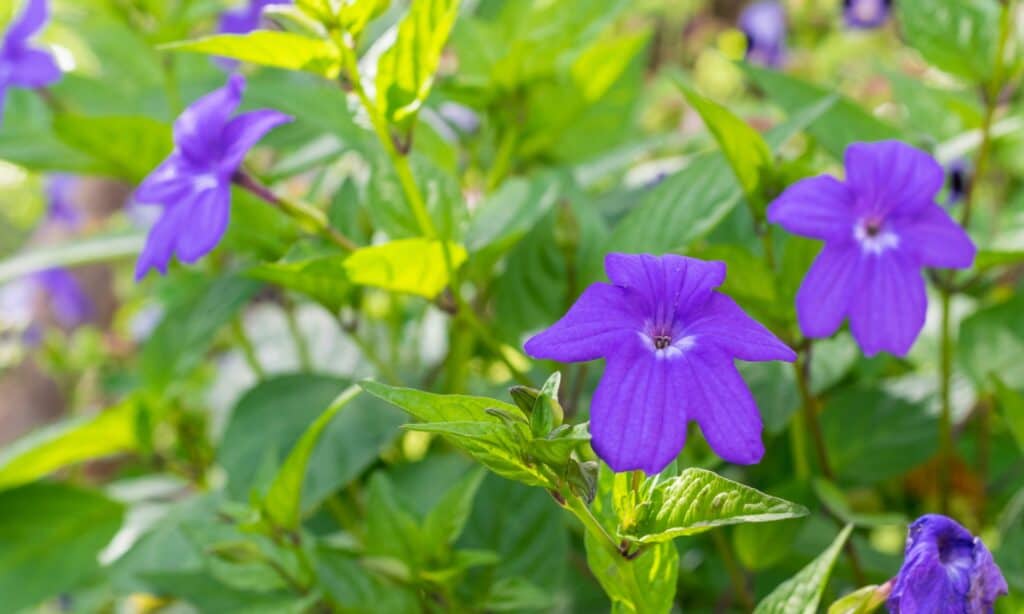
Browallia needs moist, well-draining soil.
©iStock.com/Mauricio Toro
Botanical name: Browallia americana
Common names: amethyst flower, jewel flower
USDA hardiness zones: 10 to 11
Sun exposure: full sun to partial shade
Mature size: up to 3 feet tall, with a 3-foot spread
Bloom time: summer to fall
Flower colors: blue, purple, white
For mid-size ground cover in shady gardens, grow some beautiful browallia plants! Browallia flowers come in blue, purple, or white, with blue being the most common. Its five-petaled round blooms wave from tall stems over airy, bushy foliage.
Browallia’s pretty blue flowers with white throats appear in summer and bloom until fall. And this frost-tolerant plant might even last through light snow in some areas.
- Watering needs: Browallia americana needs moist, well-draining soil.
- Maintenance: Fertilize once or twice per growing season and ensure air can flow between the plants. Stake the plants to keep them upright at full maturity.
- Garden pests: Watch for leaf damage from aphids and whiteflies.
- Common diseases: Tomato spotted wild virus and leaf spot could be challenging conditions for browallia plants.
3. Creeping Zinnia

The creeping zinnia can be up to six inches tall.
©Martina Unbehauen/Shutterstock.com
Botanical name: Sanvitalia speciosa
Common names: creeping zinnia, dwarf sunflower
USDA hardiness zones: 2 to 11
Sun exposure: full sun to partial shade
Mature size: up to 6 inches tall, with an 18-inch spread
Bloom time: spring to fall
Flower colors: yellow
Creeping zinnia is a low-growing annual perfect for areas with full or partial sun. It only gets 4 to 6 inches tall but can spread up to 2 feet wide, making it an excellent ground cover plant. The creeping zinnia is also known as a dwarf sunflower due to its similar golden blooms. So if you’re picturing a common zinnia flower with large fluffy blooms on tall single stems, this is a different plant.
The creeping zinnia is one of the best partial sun annual flowers for hot climates since this plant is drought tolerant. For this reason, it tends to grow well in rocky or sandy terrain. And this sturdy flowering annual looks wonderful growing in containers.
- Watering needs: Though they’re tolerant of high heat and drought, creeping zinnias need regular watering for moist soil.
- Maintenance: Sow this plant where you want it to stay because it doesn’t transplant well. So, plant creeping zinnias in containers if you want them to be mobile. Then fertilize every month with nutrient-rich fertilizer full of organic matter. Removing spent blooms (deadheading) is not required since the dead flowers fall on their own.
- Garden pests: Creeping zinnia is sometimes bothered by aphids, earwigs, and slugs.
- Common diseases: This plant might be susceptible to leaf spot and powdery mildew.
4. Floss Flower
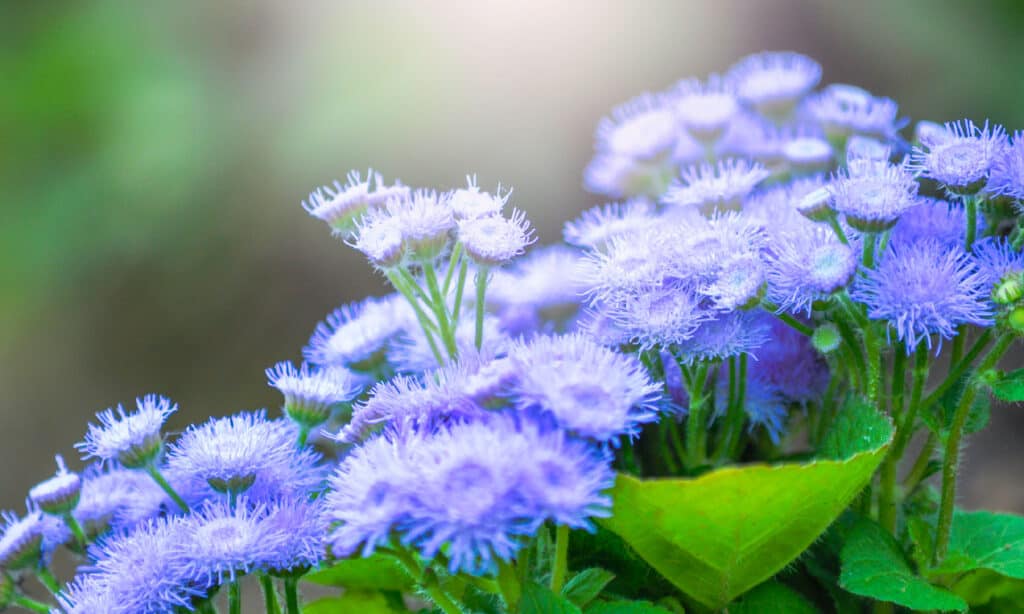
Floss flowers grow well in light shade.
©undefined undefined/Shutterstock.com
Botanical name: Ageratum houstonianum
Common names: floss flower
USDA hardiness zones: 2 to 12
Sun exposure: full sun to partial sun
Mature size: up to 12 inches tall with a 12-inch spread
Bloom time: spring to fall
Flower colors: blue, lavender, pink, white
Ageratum houstonianum, commonly known as floss flower, is a leafy plant that grows well in light shade. This partial sun annual flower has fluffy, flossy-looking clusters of blooms. And its flowers come in blue, lavender, white, and pink, depending on the cultivar (variety).
If you love blue flowers, choose floss flower cultivars like ‘Blue Mink’ or ‘Blue Horizon’ to add soothing blue tones to your garden. For pink floss flowers, try ‘Red Bouquet,’ and for white blooms, try the ‘White Bouquet’ cultivar. Fortunately, all of these beautiful varieties attract pollinators like bees and butterflies.
- Watering needs: Go easy on watering floss flowers, as they don’t do well in soggy soil.
- Maintenance: Heat-tolerant floss flowers do well in many different soil types, including sandy mixes.
- Garden pests: Aphids, mites, thrips, and whiteflies might cause harm to floss flower plants.
- Common diseases: Floss flower is prone to powdery mildew from overwatering. It’s best to water floss flower plants at the base instead of above the leaves and blooms.
5. Fuchsia
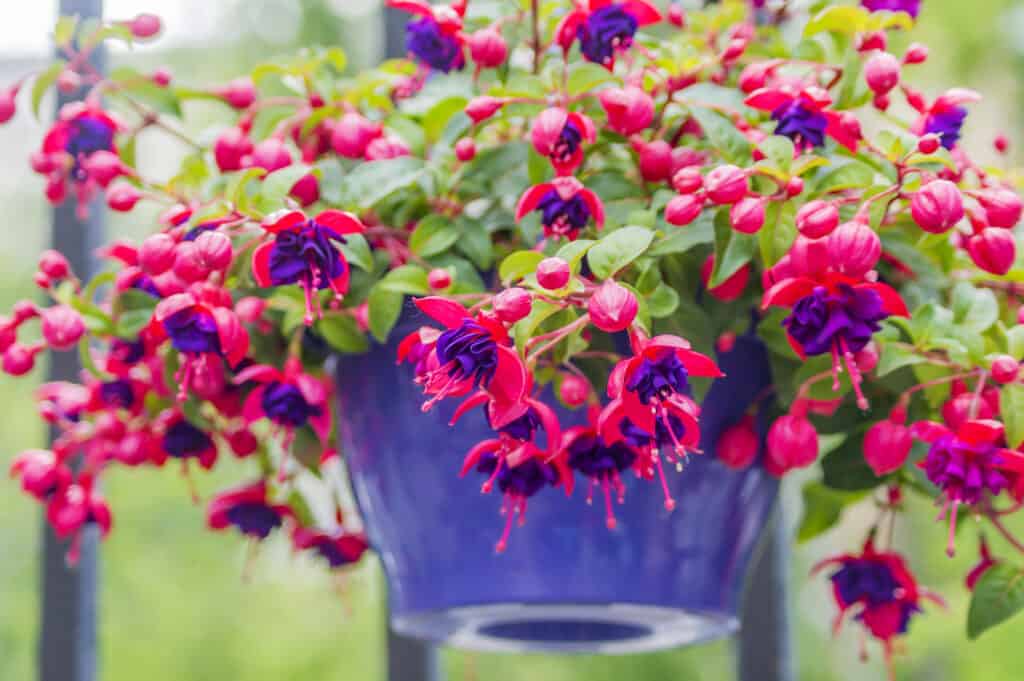
The fuchsia flower thrives in warm weather.
©iStock.com/IKvyatkovskaya
Botanical name: Fuchsia ‘Cecile’
Common names: fuchsia, lady’s eardrops
USDA hardiness zones: 9 to 10
Sun exposure: full sun to partial shade
Mature size: 2 feet tall with a 2-foot spread
Bloom time: summer to fall
Flower colors: pink and purple
Fuchsias are exciting flowers to plant in partial sun areas because they are unique and exotic-looking. For example, the Fuchia ‘Cecile’ has pillowy blooms layered like a skirt, from the dark pink petals on top (sepal) to lavender blue petals below (corolla). Additionally, these stunning upside-down tube-shaped blooms are a nectar-loving hummingbird’s dream.
This fuchsia is a shrub native to Central and South America, which is why it thrives in warm weather. But this tropical plant can’t handle too much afternoon sun since it will cause the leaves to scorch. Too little sun, on the other hand, will result in fewer blooms. Partial sun is the ideal situation for fuchsias.
- Watering needs: On average, water fuchsia shrubs once or twice a week, so their roots don’t rot. Fuchsia plants do well with moist soil. Water again once it’s gone dry.
- Maintenance: These annual flowers are generally low-maintenance. But they might need to be staked if they get too top-heavy with blooms.
- Garden pests: Unfortunately, many different garden pests love to feast on fuchsia plants, including caterpillars, capsid bugs, various beetles, mealybugs, and more.
- Common diseases: Blight, powdery mildew, root rot, rust, and leaf spot can affect fuchsias.
6. Impatiens
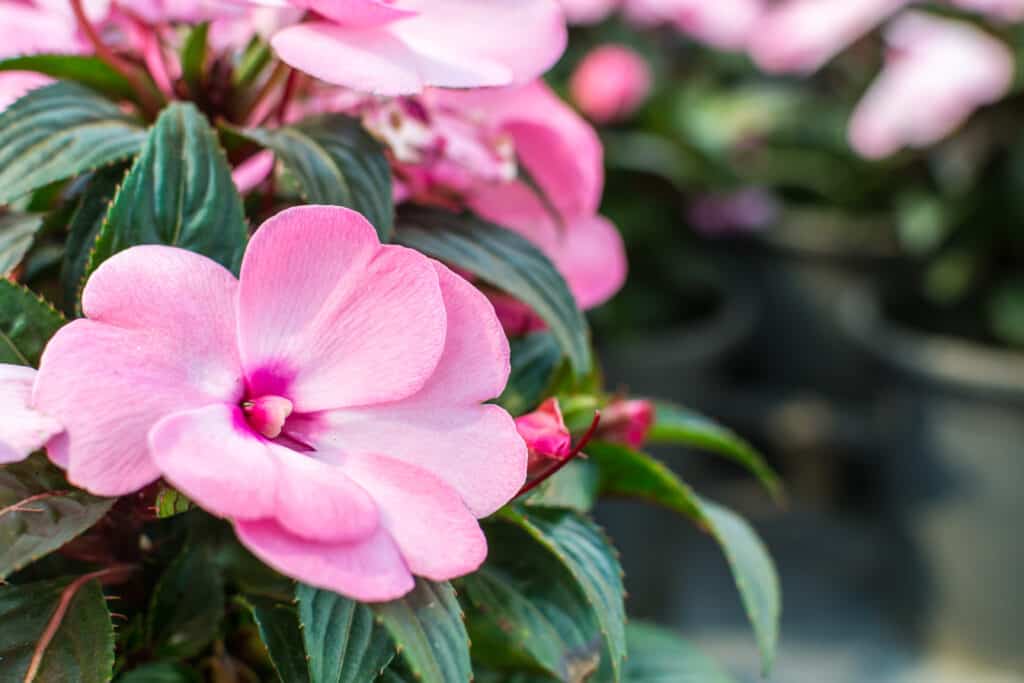
Impatiens plant is perfect for garden beds.
©iStock.com/loveischiangrai
Botanical name: Impatiens walleriana
Common names: impatiens, double impatiens
USDA hardiness zones: 2 to 11
Sun exposure: partial sun to shade
Mature size: up to 2 feet tall, 2-foot spread
Bloom time: late spring through fall
Flower colors: pink, red, coral, lavender, bicolor
Impatiens should be on every list of partial sun annual flowers for home gardens! These pretty flowers are perfect for shady porch containers and garden beds that don’t get a full day of sun. And Impatiens walleriana have double blooms that look similar to miniature roses.
Some popular Impatiens walleriana cultivars include ‘Rockapulco Appleblossom’ in soft pink and white or ‘Rockapulco Coral Reef” in bright coral. All have dark green leaves on plants that grow in mounded shapes.
- Watering needs: Impatiens don’t like to be overwatered, so be careful not to leave them sitting in soggy soil. The good news is that their lower water needs make impatiens more tolerant of heat.
- Maintenance: Self-cleaning impatiens don’t need deadheading. And they stay healthier when fertilized once every month or so.
- Garden pests: Vine weevil, spider mites, and aphids are pests that love impatiens.
- Common diseases: Watch for root rot, powdery mildew, and leaf spot development.
7. Lobelia
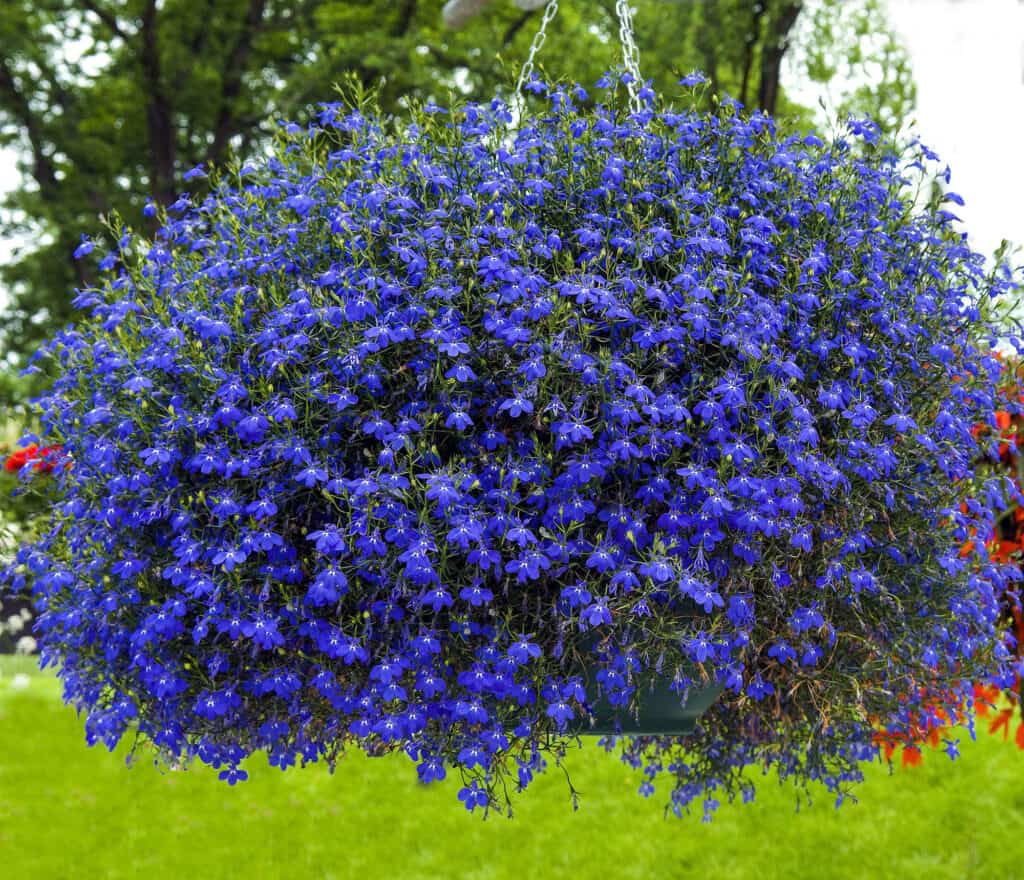
Lobelia can be up to nine inches long.
©iStock.com/emer1940
Botanical name: Lobelia erinus
Common names: edging lobelia, trailing lobelia
USDA hardiness zones: 2 to 11
Sun exposure: full sun to partial shade
Mature size: up to 9 inches tall, with a 1-foot spread
Bloom time: late spring to fall
Flower colors: blue, lavender, pink, white
Also known as trailing lobelia, this low-growing lobelia plant will delight in partially shady spots from your garden, porch, or deck. This compact plant grows many trailing stems covered with small flowers in various colors like blue and pink.
Lobelia plants sometimes take a pause from flowering in hot summer areas. Still, you can encourage new autumn blooms by cutting them back.
- Watering needs: Keep lobelia soil moist but not soggy. Watch for wilting flowers, which indicates they need more water.
- Maintenance: Lobelia isn’t a fan of high summer heat and may need extra time in the shade in late summer.
- Garden pests: If your lobelia plants turn brown, it could be from underwatering or mites have overcome them.
- Common diseases: Leaf spot from bacterial blight sometimes plagues lobelia plants. This condition sometimes develops from overwatering.
8. Peach Sage

The peach sage grows in full or partial sunshine.
©Edimoh/Shutterstock.com
Botanical name: Salvia dorisiana
Common names: salvia, fruit-scented sage, peach sage
USDA hardiness zones: 9 to 11
Sun exposure: full to partial sun
Mature size: up to 5 feet tall with a 5-foot spread
Bloom time: summer through fall
Flower colors: red
Fragrant fruit-scented Salvia dorisiana or peach sage is a heat-loving annual that grows well in full or partial sunshine. This sage or salvia plant has tiny deep-funnel flowers in hot pink that are a magnet for bees, hummingbirds, and other pollinators. And when you crush the leaves in your palm, they smell like peaches! Though some people think this plant smells like pineapple, too.
Grown as a perennial in zones 9-11, peach sage is an annual in most hardiness zones. This tall annual salvia can reach up to 5 feet tall, so it’s best suited for the back of the garden or as part of a mixed border.
- Water needs: Soil should be kept somewhat moist but don’t overwater.
- Maintenance: Peach sage is a relatively low-maintenance plant, although it may need occasional staking if grown in rich soil. Deadhead spent flowers to encourage continued blooming.
- Garden pests: Most pests aren’t interested in eating peach sage due to its pungent odor. Additionally, studies show that the essential oils of Salvia dorisiana protect other plants from many garden pests.
- Common diseases: Leaf spot and powdery mildew are common problems with salvia plants.
9. Wishbone Flower
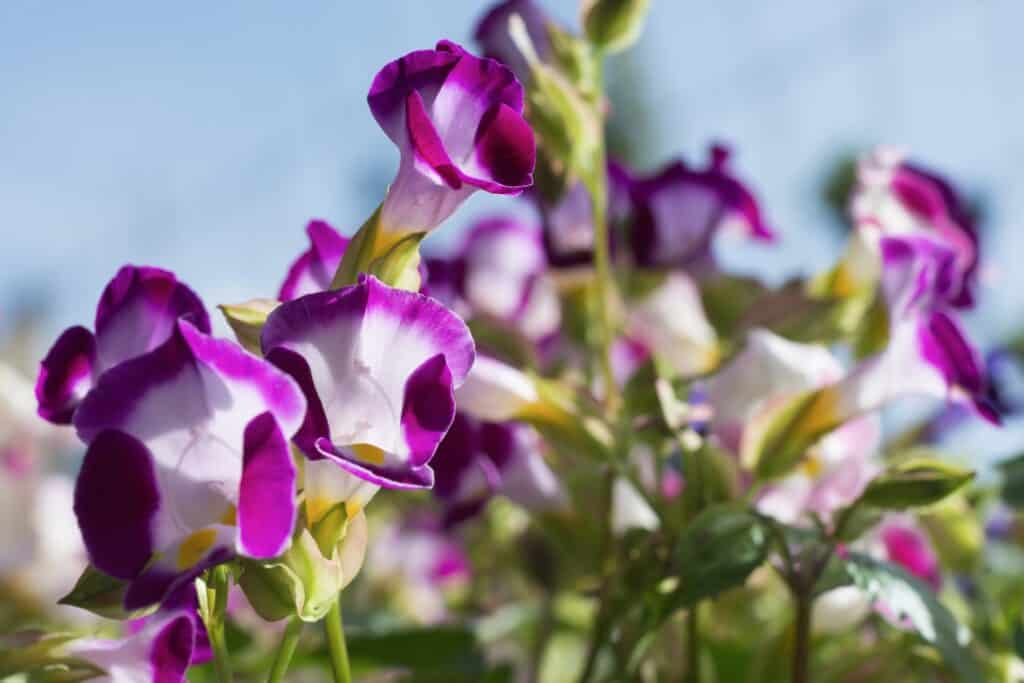
Wishbone flowers are lovely in containers.
©Isnan Wijarno/Shutterstock.com
Botanical name: Torenia fournieri
Common names: bluewing, wishbone flower
USDA hardiness zones: 2 to 11
Sun exposure: partial sun to full shade
Mature size: up to 1 foot tall, 9 inches wide
Bloom time: summer through fall
Flower colors: bi-color purple and white
The wishbone flower grows beautifully in partial sun areas of the garden. One variety has white blooms shaped like tiny trumpets with bright purple tips. And other beloved varieties of this flower come with yellow or pink blossoms, like the cultivar ‘Moon Yellow’ with golden petals and a reddish throat.
These partial sun annual flowers have bushy light-green foliage. You can keep the plants compact if you pinch the new plants back after their first season.
Wishbone flowers make great filler flowers or ground cover because of their spreading habit. They look lovely in containers, garden borders, or mass plantings.
- Watering needs: Keep this plant’s soil moist but not wet. Allow their top inch of soil to dry before watering wishbone flowers again.
- Maintenance: Pinch back the tips of stems to encourage bushier growth and more flowers. However, deadheading the Wishbone flower’s spent blooms isn’t needed.
- Garden pests: Aphids, whiteflies, and spider mites might be attracted to these plants.
- Common diseases: Wishbone flowers are disease-resistant, but root rot can be a problem in poorly drained soil. Occasionally these plants might develop powdery mildew.
Partial Sun Annual Flowers are Divine Additions to any Garden
From fluffy floss flowers to fruit-scented peach sage, this list of partial sun annual flowers has something for every garden plot or pot. And enjoying the sight of colorful blooms in those shady areas is divine when you’re sipping your sweet tea from the garden gazebo. Or your bulletproof coffee from your container garden fire escape! Whatever partial sun space you have to offer, these divine annual flowers make the day brighter.
Summary of 9 Divine Partial Sun Annual Flowers
| Flower | |
|---|---|
| 1 | Begonia |
| 2 | Browallia |
| 3 | Creeping Zinnia |
| 4 | Floss Flower |
| 5 | Fuchsia |
| 6 | Impatiens |
| 7 | Lobelia |
| 8 | Peach Sage |
| 9 | Wishbone Flower |
The photo featured at the top of this post is © iStock.com/emer1940
Sources
- University of Illinois, Available here: https://web.extension.illinois.edu/beyond/directory_annuals_shade.cfm
- National Library of Medicine (1970) pubmed.ncbi.nlm.nih.gov/22350673/
- Agriculture Victoria, Available here: https://agriculture.vic.gov.au/biosecurity/plant-diseases/flower-and-ornamental-diseases/bacterial-blight-of-lobelia
- North Carolina State Extension, Available here: https://plants.ces.ncsu.edu/plants/sanvitalia-procumbens/
Thank you for reading! Have some feedback for us? Contact the AZ Animals editorial team.






